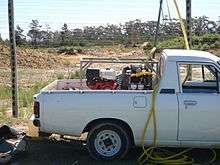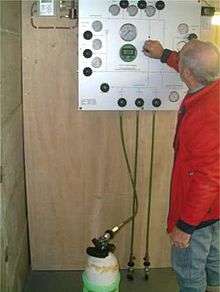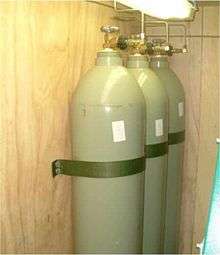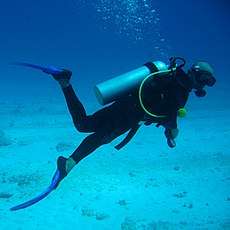Diving air compressor
|
A small stationary high pressure diving air compressor installation | |
| Other names | Breathing air compressor |
|---|---|
| Uses |
Filling dive cylinders (high pressure) Provision of surface supplied breathing air (low pressure) |

A diving air compressor is a gas compressor that can provide breathing air directly to a surface-supplied diver, or fill diving cylinders with high-pressure air pure enough to be used as a breathing gas.
A low pressure diving air compressor usually has a delivery pressure of up to 30 bar, which is regulated to suit the depth of the dive. A high pressure diving compressor has a delivery pressure which is usually over 150 bar, and is commonly between 200 and 300 bar. The pressure is limited by an overpressure valve which may be adjustable.
Machinery


High pressure diving compressors are generally three- or four-stage-reciprocating air compressors that are lubricated with a high-grade mineral or synthetic compressor oil free of toxic additives (a few use ceramic-lined cylinders with O-rings, not piston rings, requiring no lubrication). Oil-lubricated compressors must only use lubricants specified by the compressor's manufacturer as suitable for use with breathing air. Special filters are used to clean the air of most residual oil and water (see "Air purity").
Smaller compressors are often splash lubricated - the oil is splashed around in the crankcase by the impact of the crankshaft and connecting rods - but larger compressors are likely to have pressurized lubrication using an oil pump which supplies the oil to critical areas through pipes and passages in the castings. Most oil lubricated compressors will have a wet sump at the bottom of the crankcase, and require the oil level to be within limits indicated by a sight glass or dipstick for proper lubrication. The compressor should also be level within the manufacturer's specification while operating. These constraints ensure that the lubricant is in the right place for either the moving parts to contact it for splash lubrication, or for reliable suction to the oil pump. Failure to comply with these specifications can lead to damage to the compressor due to excessive friction and overheating, and contamination of the breathing air by toxic breakdown products of the lubricants.
The compression process helps remove water from the gas, making it dry, which is good for reducing corrosion in diving cylinders and freezing of diving regulators, but contributes towards dehydration, a factor in decompression sickness, in divers who breathe the gas.
Low pressure diving compressors are usually single stage compressors as the delivery pressure is relatively low.
Air purity
The compressed air output by the compressor must be filtered to make it fit for use as a breathing gas.[1] Periodically, the air produced by a compressor must be tested to ensure it meets air purity standards. Frequency of testing, contaminants that must be analysed, and the allowable limits vary between applications and jurisdictions. The following impurities may be checked for:
- Carbon dioxide –
- Carbon monoxide – A gas that is present in the exhaust gas of internal combustion engines, including those often used to drive compressors. It also comes from the breakdown of lubricating oil when compressors run too hot. Carbon monoxide is odorless, colorless, and tasteless. It is deadly even in small quantities, because it readily binds with the hemoglobin in red blood cells and thus destroys the blood's ability to carry oxygen. Breathing air compressors must be carefully designed and placed so that the compressor's intake is located in fresh air well away and upstream from any engine exhaust.[2][3]
- Lubricating-oil vapour – Oil, which must be used to lubricate the compressor's internal parts, can be harmful if it contaminates the breathing gas and is inhaled as a mist. Petroleum-based oils cannot be absorbed and metabolized by the body and will coat the internal surfaces of the lungs, causing a condition known as lipoid pneumonia and leading to asphyxiation and death. For this reason, compressors must be carefully designed and maintained to ensure that oil contamination of the breathing gas is within safe limits. Oils used should be approved by the compressor manufacturer and rated as safe for breathing air compressors. A range of mineral based and synthetic oils are supplied by several lubricant manufacturers for this application.
- Total hydrocarbons –
- Nitrogen dioxide –
- Odor and taste –
- Solid particles –
- Water vapor – Allowable limits for moisture content depend on pressure: Moist air is not harmful to the diver and reduces dehydration, so is acceptable in low pressure breathing air for surface supply in much higher concentration than for storage in high pressure cylinders, where corrosion due to condensation is a problem.[2][3]
Filtration
- Water, using silica gel, activated alumina or a molecular sieve
- Oil, using activated carbon or a molecular sieve
- Carbon monoxide, using a catalyst (Hopcalite)
- Carbon dioxide, using a prefilter may be necessary depending on intake air quality.
Low pressure filtration
The intake air for a high pressure compressor should be clean and have a low carbon dioxide content. Removal of particulate contamination is usually by a paper type dust filter at the first stage intake. Carbon dioxide can be removed by a scrubber if necessary. Clean fresh air does not need to be scrubbed at present, but inner city air may have an excessively high carbon dioxide content, and standard atmospheric air carbon dioxide content is slowly increasing. Carbon dioxide scrubbing requires moisture for the absorbent material to work effectively, and moist air is undesirable for the other filter media, so carbon dioxide scrubbing is often removed by a pre-filter system before the air is compressed.[2][3]
High pressure filtration systems
When the air is compressed, the partial pressure of water vapour is proportionately increased. The air is also heated by compression, and when cooled between stages in the inter-cooler coils, the relative humidity increases, and when it exceeds 100% will tend to condense out onto the surface of the tubes and as droplets carried by the air-stream. The air from the inter-cooler coils is led into the large diameter vertical axis tube of a separator, where it changes direction by about 90 degrees and is slowed down considerably. When the airflow changes direction towards the outlet at the top of the separator casing, the denser droplets have a tendency to hit the walls and coalesce into a film, which will flow downwards to the bottom of the separator and collect there where it can be periodically discharged through a drain valve. This reduces the water content of the outlet air, which is then compressed again in the next stage cylinder, cooled again, and the water that condenses out is again removed by the next separator.[2][3]
After final stage separation the relatively dry air passes through the filter to remove yet more water, and any other contaminants that the filter media will adsorb. The efficiency of dehumidification and filtration depends on significant compression and limited flow velocity, which requires back-pressure at the final stage outlet to resist flow when the filling pressure is low. The back-pressure valve provided in the outlet from the final filter stack is usually set to near the working pressure of the compressor to ensure that the air is compressed sufficiently for the filters to work effectively.[2][3]
Delivered air should have a dew point lower than the operational temperature of the cylinder, which is generally above 0°C when immersed, but can be colder during transport. Air temperature is also decreased during expansion through the regulator when in use, and when this temperature is low enough for the condensate to freeze, it can lock up the moving parts of the regulator and cause a free flow, known as internal icing. Correct back-pressure also provides relatively even loading of the compressor stages, which reduces vibration caused by imbalance, and extends the compressor service life.[2][3]
The final stage of air treatment is filtration of residual moisture, oil and hydrocarbons, and where necessary catalytic conversion of carbon monoxide. All of these depend on sufficient time in contact with the filter media, known as "dwell time", so either the filter must have a long air path or the air must flow slowly. Slow air flow is easily achieved by high compression, so filtration works best at or near the working output pressure of the compressor, and this is achieved by the back-pressure valve, which only allows air to flow above the set pressure.[2][3]
The activated carbon filter medium works best when dry, so it is usually loaded into the filter stack so that the air will first flow through the dessicant media, commonly molecular seive. Hopcalite catalyst will convert carbon monoxide into carbon dioxide, but requires very dry air - relative humidity must be below 50% - so hopcalite is loaded downstream from the dessicant. A carbon dioxide absorbent may be loaded downstream of the hopcalite.[2][3]
Pressure



Diving compressors generally fall into one of two categories: those used for surface supplied diving and those used for filling scuba diving cylinders and surface supply storage cylinders.
Surface supplied diving compressors are low-pressure and high-volume. They supply breathing air directly to a diver, through a control panel sometimes called a "rack" via a hose which is usually part of a group of hoses and cables called an "umbilical". Their output is generally between 6 and 20 bars (100 and 300 psi). These compressors must be sufficiently powerful to deliver gas at a sufficient pressure and volume for multiple divers working at depths of up to about 60 metres (200 ft).
Compressors used to fill scuba cylinders have a high delivery pressure and may have a low delivery volume. They are used to fill diving cylinders and storage cylinders or banks of storage cylinders. These compressors may be smaller and less powerful because the volume of gas they deliver is not so critical as it is not directly used by the diver; a lower volume compressor can be used to fill large storage cylinders during the periods when demand is low. This stored compressed air can be decanted into diving cylinders when needed. Common scuba diving cylinder pressures are 200 bar (2940 psi), 3000 psi (207 bar), 232 bar (3400 psi) and 300 bar (4500 psi).
Heat of compression
When diving cylinders are filled the gas inside them warms as a result of adiabatic heating. When the gas cools by losing heat to the surroundings, the pressure will drop as described by the general gas equation and Gay-Lussac's law. Divers, to maximise their dive time, generally want their cylinders filled to their safe capacity, the working pressure. To provide the diver with a cylinder filled to the working pressure at the nominal temperature of 15 or 20 °C, the cylinder and gas must be kept cool when filling or filled to a pressure such that when it cools it is at the working pressure. This is known as the developed pressure for the filling temperature. Health and safety regulations and pressure vessel design standards may limit the working temperature of the cylinder, commonly to 65 °C, in which case the cylinder must be filled slowly enough to avoid exceeding the maximum working temperature.[4]
Cylinders are often filled at a rate of less than 1 bar (100 kPa or 15 lbf/in²) per second to allow time for heat transfer to the surroundings to limit this increase in temperature. As a method to remove heat faster when filling the cylinder, some filling stations “wet fill” cylinders immersed in a bath of cold water. There is an increased risk of internal cylinder corrosion caused by moisture from the wet environment entering the cylinder due to contamination during connection of the filling hose during wet filling.[5]
The bank
Compressors may be connected to a bank of large, high-pressure cylinders to store compressed gas, for use at peak times. This allows a cheaper low-powered compressor, which is relatively slow at pumping gas, to fill the bank automatically during idle periods, storing a large volume of pressurized air so that a batch of cylinders can be filled more quickly at peak demand without being delayed by the slow-running compressor. In surface-supplied diving, high-pressure cylinder banks may be used as an emergency backup in case of primary compressor failure, or they may be used as the primary source of breathing gas, a system also known as "Scuba replacement".
Gas blending

Compressors may be linked to a gas blending panel to make nitrox, trimix, heliair or heliox mixes.[6] The panel controls the decanting of oxygen and helium from cylinders bought from commercial gas suppliers.
As it is not possible to decant to a diving cylinder from a storage cylinder that holds gas at a lower pressure than the diving cylinder, the expensive gas in low pressure storage cylinders is not easily consumed and may go to waste when the storage cylinder is returned to the supplier. The cascade system may be used with a bank of storage cylinders to economically consume these high cost gases so that the economically maximum gas is used from the bank.[6] This involves filling a diving cylinder by first decanting from the bank cylinder with the lowest pressure that is higher than the diving cylinder's pressure and then from the next higher-pressure bank cylinder in succession until the diving cylinder is full. The system maximizes the use of low-pressure bank gas and minimizes the use of high-pressure bank gas.
Another method for scavenging expensive low pressure gases is to pump it with a gas booster pump such as a Haskel pump,[6] or to add it to the intake air of a suitable compressor at atmospheric pressure in a mixer known as a blending stick.
References
- ↑ Millar IL; Mouldey PG (2008). "Compressed breathing air – the potential for evil from within". Diving and Hyperbaric Medicine. South Pacific Underwater Medicine Society. 38: 145–51. Retrieved 2009-02-28.
- 1 2 3 4 5 6 7 8 9 Burton, Stephen E. "High Pressure Breathing Air Compressor Filtration System Design". scubaengineer.com. Retrieved 10 March 2018.
- 1 2 3 4 5 6 7 8 9 Green, Ted. "Understanding SCUBA Compressors and Filtration" (PDF). Australian National University SCUBA Diving Club. Retrieved 10 March 2018.
- ↑ South African National Standard SANS 10019:2008 Transportable containers for compressed, dissolved and liquefied gases - Basic design,manufacture, use and maintenance (6th ed.). Pretoria, South Africa: Standards South Africa. 2008. ISBN 978-0-626-19228-0.
- ↑ Calhoun, Fred. "The case for Dry-filling scuba tanks" (PDF). Archived copy of The Best of Sources. pp. 146–149. Archived from the original (PDF) on 2009-09-20. Retrieved 14 December 2016 – via webarchive.org.
- 1 2 3 Harlow, V (2002). Oxygen Hacker's Companion. Airspeed Press. ISBN 0-9678873-2-1.
External links
%2C_is_fitted_with_a_Kirby_Morgan_37_Dive_Helmet.jpg)
